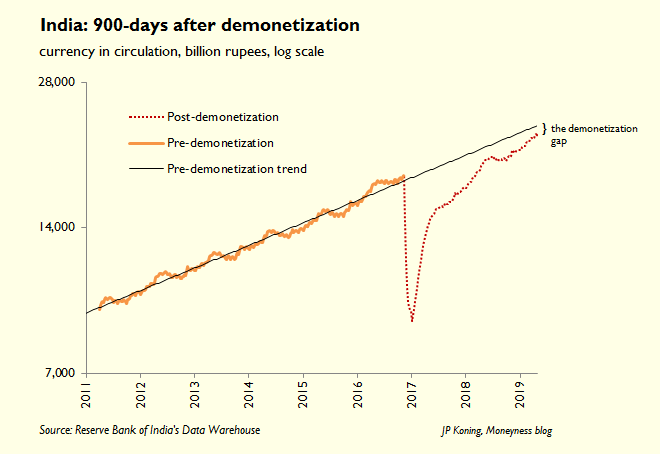Interesting ongoing debate on inflation dynamics in India. Mainstream
discussion points to two structural factors. One the MPC and Inflation Targeting framework; and second the reforms on the agriculture side.
The argument on MPC/IT framework is perhaps not a very compelling one, given the fairly strong body of global research which questions the efficacy of IT framework, especially for developing countries. See
this,
this,
this, and
this, all by IMF. In fact, on the inflation count, I would be more inclined to argue that the credit should go to the Government in having exercised restraint on the fiscal front (especially when compared to the previous regime).
This brings us to the argument that supply-side factors on agriculture have been responsible for the disinflation of recent years. Sample this,
“We believe the key driver of the collapse in vegetable prices has likely been the deregulation of markets. Vegetables inflation declined sharply in 2014 and 2015 and has stayed low since then. The timing of the sharp drop in vegetables inflation coincides with the delisting of vegetables from the Agriculture and Product Marketing Committee (APMC) Act in 14 states.” (Prachi Mishra)
I doubt the impact of this transmission channel for several practical reasons. The APMC Act implementation has been very tardy. This is understandable given that its implementation is not just a legislative enactment but creation of a whole set of enabling market facilitation infrastructure and systems, as well as the political economy challenges with breaking the stranglehold of brokers and mandis. These will take time, even long time, to make any meaningful impact. It is also factually borne out that intra-mandi trades, even in the states where APMC implementation has progressed reasonably well, have been negligible. Even the volumes on e-NAM have been very small, and a significant proportion are effectively off-line business-as-usual transactions whose data have been digitised.
The most charitable thing that can be said about monetary policy lowering inflation is perhaps of its classic indirect effect,
“People seem to overlook that this structural decline in inflation may have something to do with the inflation-targeting credibility that central banks and the RBI have earned the hard way. A change in central bank objective, i.e., it will not hike until and unless inflation has become entrenched, could well erode this credibility, un-anchor inflation, and start an inflation spiral. Would India like to risk this?” (Jahangir Aziz)
But this is too general and applicable to any country or context. It is difficult to believe that a 2-3 year old IT regime could have firmed up expectations so strongly. In fact, this is more likely due to the fairly long history of RBI being a relatively independent and credible institution, rather than any recent institutional shifts or personalities. And herein lies the need for governments to exercise restraint on how much it interferes with the central bank's actions.
For now, the only thing we can be sure is that food price inflation has been declining. And core-inflation though running over 4% has been stable.
So it may be reasonable to argue that we are experiencing low inflation because of a confluence of happenstance factors (oil prices, global economic cycle etc) and low aggregate demand in general, coupled with the government’s restraint on fiscal slippage (especially, the restraint on MSP etc).
In the context of the low food prices, this collateral damage from the war on inflation is interesting,
“We don’t see inflation because we are focused on urban households. The continued food disinflation… has resulted in the terms-of-trade that farmers face to sink to their lowest in over 35 years.” (Jahangir Aziz)
This is borne out by the recent work of Ashok Gulati etc, which show that Producer Price Index faced by Indian farmers has been
the most adverse among large economies in recent years. Some commentators have pointed to structural factors like the transition to an
“age of surplus” from one of production deficits. In any case, farmgate prices have been falling. The issue of general distress facing the farm sector in India therefore appears unsurprising.
This takes us to the classic conundrum. Low food prices hurt farmers. And high food prices hurt the urban consumers. The latter being more vocal, their concerns are more likely to influence the considerations of the technical experts in the RBI. Amplifying this would be the theoretical models which would have it that higher food prices feed into inflation and impact macroeconomic stability.
We know that in any democracy, the considerations of both constituencies have to be taken into account. The latter (producers) especially so given that they form the majority of the country’s population and that of the poor. But monetary policy experts generally do not take this into consideration in their rate-setting decisions. The IT framework only exacerbates this skewed decision-making calculus.
Not to speak of the questionable value of interest rate policy when faced with cost-push inflation arising from the numerous (and recurrently surfacing) supply side constraints in the food market.
Would the defenders of RBI's sole pursuit of inflation ignoring the government's repeated calls to take economic growth into account, acknowledge this failing of their model? Does this also raises questions about the orthodoxy on monetary policy in India?






